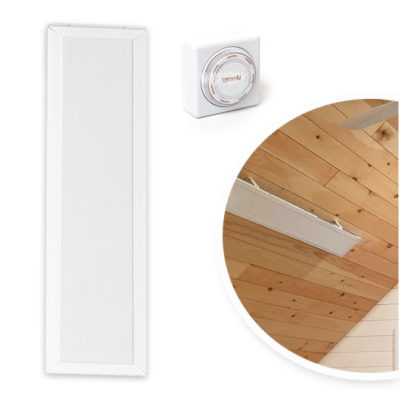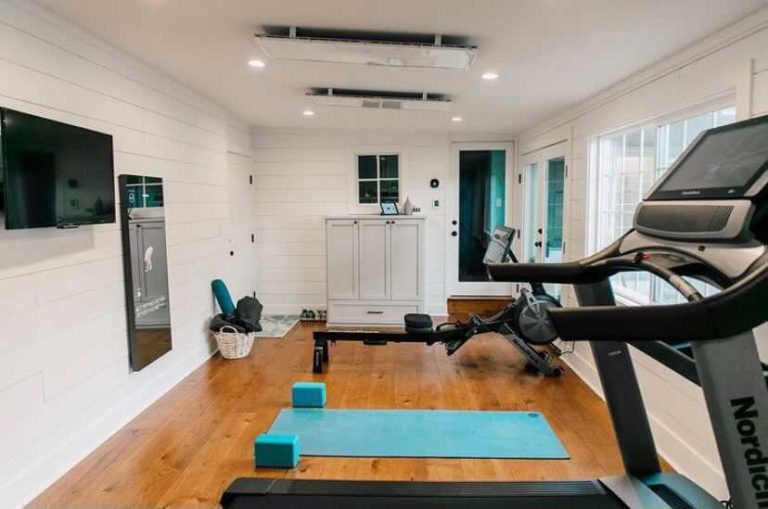Here are a few things you need to know about heating for home hot yoga.
If you love to practice hot yoga and have wondered if you can do this at your house, the short answer is yes! However, there are a few factors to be aware of to make sure that you accomplish the temperature and ambiance that you want. Many hot yoga studios are in the 90 to 105 degree range, with some that go to 110 degrees or more! The two most common styles of hot yoga which are practiced are Vinyasa (in the mid 90s typically), and Bikram (around 105-106 degrees typically). For Bikram there is often also humidity added, in order to reach a 40-50% relative humidity. To learn more about the supplemental systems to enhance your home yoga studio, visit our blog post regarding this here.Factor 1: Heater
Finding the right heater for home hot yoga is important. There is a plethora of options for heaters available which can warm up a room to some degree. The most common traditional heater is a forced air (or convective) type of heat which blows hot air in a room and causes the air temperature to rise. However, most convective forms of heat are not designed to operate at high temperatures, and they are also inefficient, loud, and do not create the right ambiance for yoga.
Over the last 10-15 years infrared heat has been increasingly used as the way to heat both commercial and home yoga studios, because of its several advantages over forced air. Infrared is silent and can operate at very hot temperatures without any problem. It is more efficient as it primarily heats mass in a room (objects/people), and objects retain heat better than air.Most importantly, the physiological effect of infrared heat has health benefits such as increased flexibility and detoxification, and also feels a lot warmer. It feels similar to standing outside on a warm sunny day, or warming up next to a campfire or wood stove. Heat from the sun and from fire are both great examples of infrared. The only difference is that for infrared heaters in a studio, you are powering them with electricity instead of wood or nuclear fusion 🙂
So what infrared heaters are best for your home hot yoga studio? We will dedicate a whole blog post to this soon, and there’s also literature in our yoga brochure which explains more on the features and benefits of Heating Green’s infrared systems. Here’s a map too with some of the 1,000+ commercial yoga studios who use our infrared heaters.
Factor 2: Square Footage (and cubic footage)
 The size of your room makes a huge difference in how much heat you will need to reach a hot yoga temperature. Trying to decide between your spare bedroom and your rec room? Unless you need to host 5-10 yogis for your home classes, choose the bedroom! It will cost you about 1/3 of the cost for the infrared heaters, it will cost you less to operate, and it’s usually going to cost less to install too. When considering what amount of square feet is the right amount, think about how much room you’ll comfortably need to lay out your mat and be able to do poses without feeling constrained.
The size of your room makes a huge difference in how much heat you will need to reach a hot yoga temperature. Trying to decide between your spare bedroom and your rec room? Unless you need to host 5-10 yogis for your home classes, choose the bedroom! It will cost you about 1/3 of the cost for the infrared heaters, it will cost you less to operate, and it’s usually going to cost less to install too. When considering what amount of square feet is the right amount, think about how much room you’ll comfortably need to lay out your mat and be able to do poses without feeling constrained.
Some customers use a medium to large size bathroom. The advantage to doing this is that you can reach 105 degrees with a plug-in option (an infrared heater that plugs in to an outlet). For a bedroom or any larger room, to reach a Bikram temp usually requires more power than is available in the outlets alone, which means that an electrician will need to hardwire it (or for you DIY’ers it means you’d need to run an extension cord from a different electrical circuit in another room!). For Vinyasa it’s within reason to have a plug-in solution in a smaller bedroom, for reference.
Lastly, on the comment of square footage it’s also worth considering the cubic footage i.e. if you have high ceilings or a vaulted ceiling, this is more volume of air in the room and consequently will require more heat to compensate for that volume.
Factor 3: Heat Loss
 Heat loss can be a bit tricky and it’s often overlooked when we consider how much heat is needed for a hot yoga studio. We often see this in commercial studios, some of which have equivalent watt density (same intensity of infrared per square foot), and those that have minimal heat loss can go much hotter and also get there quicker! Consider your room that you want to heat. Are the windows double pane? Are doors sealed, is there insulation above you and in the walls? Is your flooring finished with insulation below or is it unfinished (such as concrete)? If your answer is no, don’t worry! It just means that you’ll either have a bit longer warm up time or may need a bit more heat. For example, I have (2) 1,000W Heating Green Cove heaters in 90sq ft with 2 large single pane windows, and the temp still goes over 100 degrees.
Heat loss can be a bit tricky and it’s often overlooked when we consider how much heat is needed for a hot yoga studio. We often see this in commercial studios, some of which have equivalent watt density (same intensity of infrared per square foot), and those that have minimal heat loss can go much hotter and also get there quicker! Consider your room that you want to heat. Are the windows double pane? Are doors sealed, is there insulation above you and in the walls? Is your flooring finished with insulation below or is it unfinished (such as concrete)? If your answer is no, don’t worry! It just means that you’ll either have a bit longer warm up time or may need a bit more heat. For example, I have (2) 1,000W Heating Green Cove heaters in 90sq ft with 2 large single pane windows, and the temp still goes over 100 degrees.
In conclusion, there are a few significant considerations to take into account when trying to decide how to heat your home hot yoga studio. We also are glad to explain in more detail what it will take for your room specifically, and answer any of your infrared questions. You can contact us here for more information.
See what yoga Instructors recommend for at home hot yoga essentials in New York Magazine, Everything You Need for At-Home Hot Yoga, According to Instructors. Which includes our Plug-In Home Hot Yoga Package.Written by: Jeff Abel, VP of Sales, Heating Green

